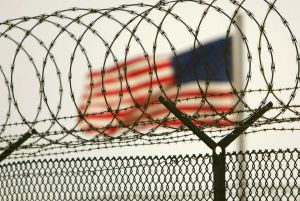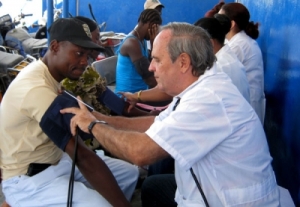
by Salim Lamrani
This post first appeared in Opera Mundi
The United States has once again placed Cuba on the list of countries involved in human trafficking. However, international institutions repudiate Washington’s perspective. On the other hand, according to Human Rights Watch, the United States is the only developed country to legally permit the exploitation of child labor from the age of 12 years.
In its 2014 report on countries that engage in human trafficking, the U.S. State Department has once again included Cuba, even placing it in its worst offender category. According to Washington, “adults and children [on the island] are victims of sex trafficking and forced labor. Child prostitution and sex tourism in Cuba is a reality […]. There were allegations of forced labor during missions abroad conducted by the Cuban government.” (1)
However, Washington acknowledges the lack of reliability of its own sources:
“Some Cubans participating in the work missions have stated that the postings are voluntary, and that the positions are well paid compared to jobs within Cuba. Others have claimed that Cuban authorities have coerced them by withholding their passports and restricting their movements. Some medical professionals participating in the missions have been able to take advantage of U.S. visas or immigration benefits, applying for those benefits and arriving in the United States in possession of their passports–an indication that at least some medical professionals retain possession of their passports. Reports of coercion by Cuban authorities in this program do not appear to reflect a uniform government policy of coercion; however, information is lacking.” (2)
The report includes, inter alia, a reference to the Cuban Medical Professional Parole Program (CMPP). Indeed since 2006, Washington has implemented a policy aimed at plundering the island of its human capital by facilitating the emigration of medical staff to the United States. This program primarily targets the 30,000 Cuban doctors and other health personnel working in nearly 60 countries of the Third World as part of a vast humanitarian campaign begun by Cuba in 1963 to bring health care to the world’s poor. (3)
Thus, despite its self-acknowledged lack of reliable information, the 2014 report concludes that “The government of Cuba does not fully comply with the minimum standards for the elimination of trafficking and is not making significant efforts to do so.” (4)
The view of UNICEF
The most serious charge concerns child prostitution. Yet UNICEF — the United Nations Children’s Fund — does not share this opinion and, in fact, salutes the advances made by Cuba in the field of child protection. According to the UN agency, “Cuba is an example in the protection of children.”5 According to José Juan Ortiz, UNICEF’s representative in Havana, “severe malnutrition does not exist in Cuba [because] there is the political will” to eliminate it. “Here, there are no children in the streets. In Cuba, children are always a priority and that is why they do not suffer from the shortages that afflict millions of other children in Latin America, who work, who are exploited or who are involved in prostitution networks.” (6)
Ortiz shared his experience on this subject:
“There are millions of children who are exploited every day, who never go to school; millions of boys and girls who do not have a legal identity, who do not exist because they are not included in the census. (7)
“Cuba, for more than 50 years, has been a model for the defense and promotion of the rights of children. Public policies that favor children have been a priority for years. Because of this, the country has achieved a position that is truly unique in the developing world. Of the hundreds of millions of boys and girls who suffer serious violations of their rights every day, even dying for absolutely preventable causes, none of these children are Cuban. The Cuban experience is a clear demonstration of what is possible if governments pay attention to children and make them a priority.
“[…] Cuba demonstrates that, despite the international crisis, despite the [U.S.] economic sanctions and their severe impact upon child development — Cuba is the only country that suffers from these sanctions — despite all of this, it is nonetheless possible to guarantee fully the rights of the child and achieve increasingly high levels of human development as is the case in Cuba. Cuba is an example to the world of how to work to ensure the rights of the child and realize full development. The Cuban people enjoy a treasure that sometimes they do not realize they have. Cuban children and adolescents are privileged in comparison with the rest of world. (8)
“Twenty thousand children will die in the world [today], and the overwhelming majority of these deaths could be prevented. It is criminal to allow children to die when we have the means to save them. Were the issue of childhood a global priority, the problems faced by children would have been resolved a long time ago, as they have been in Cuba.
“Cuba has always been an example in terms of social development, with levels of equality similar to those in the most highly developed countries.
“The work accomplished in Cuba with juvenile offenders (another great theme and challenge for Latin America and the Caribbean) is exemplary. Here, there are no children behind bars. The system prioritizes the rehabilitation of misguided youth […]. Furthermore, all children with disabilities are supported, even in their homes if the child is not ambulatory. This is an exceptional advance. […]. Cuba is the only country I know where you can celebrate by dancing on International Children’s Day […].” (9)
The UNICEF representative also stressed the following: “Because of my job, I spend time burying children in all of the countries I visit. In Cuba, however, I spend time playing with them.” He did not hesitate to call the island a “childhood paradise in Latin America.”10 UNICEF notes that Cuba is the only Latin American or Third World country to have eradicated infantile malnutrition. (11)
Havana’s Response
On Havana’s side, authorities have strongly condemned the inclusion of Cuba, present on their blacklist since 2003, among the group of countries involved in human trafficking, and described the report as “manipulative and unilateral:” (12)
“The State Department has once again decided to include Cuba in its worst offender category (level 3) of its annual report of countries that ‘do not fully comply with the minimum standards for the elimination of trafficking and are not making significant efforts to do so.’ At the same time, they ignore the recognition and prestige achieved by our country for its strong commitment to the protection of children, youth and women.
“Cuba has not requested the evaluation of the United States nor does it need the recommendations of one of the countries that has the highest number of cases of trafficking of children and women in the world. The United States has no moral authority to call down Cuba, nor to suggest ‘plans’ of any kind. It is estimated that the number of North-American citizens who are victims of trafficking is close to 200,000 and that labor exploitation is its most widespread form. Eighty-five percent of the court trials dealing with trafficking involve sexual exploitation and more than 300,000 children, among the million who run away from home, are subject to some form of exploitation […].
“Inclusion on this list for entirely political reasons, as well as the designation of Cuba as a state sponsor of international terrorism, is an attempt to justify the policy of economic blockade […] something that seriously affects our children, our youth, our women and our entire population.”(13)
Washington recognizes the incomplete nature of its report and UNICEF has seriously undermined its accusations against Cuba. Furthermore, the involvement of the United States itself in human trafficking, and the legal exploitation of children from the age of 12, diminishes its moral authority and deals a severe blow to its credibility.
Trafficking of Human Beings in the United States
The United States maintains that it considers the struggle against human trafficking a priority. According to John F. Kerry, the United States “has a moral obligation to address this challenge [because] trafficking is an attack against our most cherished values such as freedom and human dignity.” (14)
However, on this issue, the State Department report itself is also highly critical of Washington. Indeed, “The United States is a source, transit, and destination country for men, women, and children — both U.S. citizens and foreign nationals — subjected to sex trafficking and forced labor, including domestic servitude.” (15)
According to the same report:
“Abuse of third-country nationals providing services for U.S. defense contracts in Afghanistan also has been noted by the media. NGOs reported that visa holders employed as domestic workers were subjected to forced labor by personnel of foreign diplomatic missions and international organizations posted to the United States; Native American women and girls were trafficked for the purpose of commercial sex acts; and LGBT youth were particularly vulnerable to traffickers.” (16)
The Human Rights Watch Report
Moreover, the United States is probably the only developed country where children can be exploited legally by being allowed to work at the age of 12. Human Rights Watch (HRW), an organization for the defense of human rights, has denounced the exploitation of children in the country’s tobacco fields. According to this organization, these children are, on average, 13 years old and may work up to 60 hours per week. According to an HRW survey, 53 percent of them are exposed to pesticides, 66 percent suffer from recurrent symptoms such as “vomiting, nausea, headache, dizziness, and loss of appetite” due to exposure to nicotine and 73 percent have already been sick with “nausea, headaches, respiratory diseases, skin problems and other symptoms.”(17)
According to HRW:
children work long hours without overtime pay, often in extreme heat without shade or sufficient breaks, and wear no, or inadequate, protective gear.” They are thus “exposed to dangerous nicotine without smoking a single cigarette.” Children are also forced to handle “dangerous tools and machinery, lift heavy loads, and climb several stories without protection for hanging tobacco in barns. (18)
The organization added that “tractors sprayed pesticides in nearby fields,” seriously affecting the health of children, who stressed that “the spray drifted over them, making them vomit, feel dizzy, and have difficulty breathing and causing a burning sensation in their eyes.” In addition, most of the pesticides used in tobacco production are “known neurotoxins, poisons that alter the nervous system.” Such exposure, over the long term, can cause “cancer, cognitive and learning problems and infertility.” HRW notes that “Children are especially vulnerable because their bodies and brains are still developing.” Moreover, “most children interviewed by Human Rights Watch said they had no access to toilets or a place to wash their hands at their worksites, leaving them with tobacco and pesticides residue on their hands, even during mealtimes.” (19)
In 2012, 70 percent of children under the age of 18 who died of a work accident were agricultural workers. Adequate protection is not provided by United States labor law. Thus, children may be exploited in agriculture from the age of 12 and work “longer hours, at younger ages, for less pay, in more hazardous conditions than children in any other industry.” (20)
The inclusion of Cuba on the list of countries involved in human trafficking is, it appears, motivated more by political and ideological considerations than by precise and verifiable facts. Indeed, international organizations, particularly those responsible for child protection such as UNICEF, repudiate Washington’s position on the exploitation of minors. Rather, they praise the social policies that favor the protection of children on the Caribbean island. Additionally, the United States, a hub of human trafficking according to its own report, is the only developed country to allow the legal exploitation of children as young as 12, thereby casting a shadow over its credibility once it becomes a question of the defense of human rights.
Translated from the French by Larry R. Oberg.
References:
1 United States Department of State, “Trafficking in Persons, Report 2014,” June 2014. http://www.state.gov/j/tip/rls/tiprpt/2014/index.htm (site consulted June 27, 2014), p.148.
2 Ibid., p.148-149.
3United States Department of State, “Cuban Medical Professional Parole Program”, June 26, 2014. (site consulted July 2, 2014).
4 United States Department of State, “Trafficking in Persons, Report 2014,” June 2014, op. cit., p. 149.
5 José A. De la Osa, “Cuba es ejemplo en la protección a la infancia,” Granma, April 12, 2008.
6 Fernando Ravsberg, “UNICEF : Cuba sin desnutrición infantil,” BBC, January 26, 2010.
7Radio Havana Cuba, “l’UNICEF signale que Cuba est un exemple en matière des droits de l’homme,” June 1, 2012.
8Cubainformación, “Entrevista a representante de UNICEF en Cuba,” June 4, 2012. http://www.cubainformacion.tv/index.php?option=com_content&task=view&id=43657&Itemid=86 (site consulted January 2, 2013.
9 Lisandra Fariña Acosta, “Ce pays est un laboratoire de développement social,” Granma, June 7, 2012. http://www.granma.cu/frances/cuba-f/7jun-Ce%20pays.html (site consulted January 2, 2013).
10 Marcos Alfonso, “Cuba : ejemplo de la protección de la infancia, reconoce UNICEF,” AIN, July 18, 2010.
11 UNICEF, Progreso para la infancia. Un balance sobre la nutrición, 2011.
12 Agence France Presse, “Cuba califica de ‘manipulador y unilateral’ informe de EEUU,” June 21, 2014.
13 Josefina Vidal Ferreiro, “Declaración de la Directora General de Estados Unidos del Ministerio de Relaciones Exteriores de Cuba,” República de Cuba, June 21, 2014.
14 Le Monde, « Le rapport américain sur la traite d’humains provoque un tollé », June 20, 2013.
15 State Department, « Trafficking in Persons, Report 2014 », June 2014. http://www.state.gov/documents/organization/226849.pdf (site consulted June 30, 2014), p.30-36.
16Ibid.
17 Human Rights Watch, « US : Child Workers in Danger on Tobacco Farms”, May 14, 2014. http://www.hrw.org/news/2014/05/14/us-child-workers-danger-tobacco-farms#infographic (site consulted June 30, 2014).
18 Ibid.
19 Ibid.
20 Ibid.








